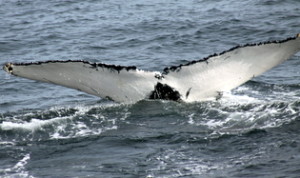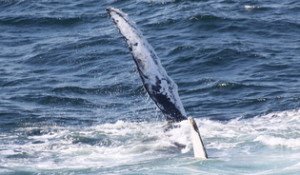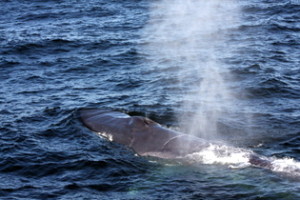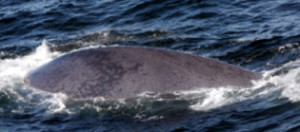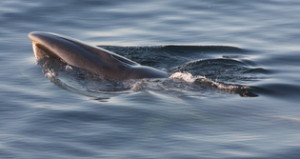October 1 to October 7
It was a blustery week out there and there were only a few days when we were able to get out on the water, but on October 1st we headed way offshore — 21 miles from Race Point — to find 10-12 humpbacks lunging near the surface. The patchy fog that had plagued the morning’s trip had cleared and we found ourselves looking at a group of 10-12 humpbacks, including Laridae and Gladiator, both feeding near the surface. We suspected that the layer of food must have been right below the surface because these whales would dive down and then pop right back up again with a mouthful of food!
At one point, Downsweep took a break from feeding to execute a huge breach right off the bow of the Dolphin IX! Downsweep is named for the distinct marking on the lower right fluke.
Amidst the feeding whales were a few great bird sightings. One Pomerine jaeger, flew alongside the side of the Dolphin VIII before swooping back towards the rest of the feeding birds. A Northern fulmar was also spotted among the gulls. Both of these birds are gull-sized, and sometimes hard to pick out from a big group of birds; however, they can be distinguished by their stockier builds and distinct coloring.
High winds and rain kept us tied to the pier until October 4. It was still choppy, but at the very least sunny skies kept us warm as we ventured far offshore. It wasn’t until we were north of the old BE buoy when we picked up a fin whale. We had a few looks at this whale whose distinct scars were suggestive of a prior shipstrike.
In between one of this whales’ long dives we saw a splash off in the distance. It turned out to be a small unidentified humpback. It tail breached once, rolled on its side and slapped its flipper once, and by that time we had to head back to shore!
Interesting bird sightings continued throughout the day. Despite the dropping temperatures, there are still a few Great Shearwaters hanging around, as more typically fall sightings become more common. Each trip has been lucky enough to spot a Northern fulmar or two, and mature gannets, distinguishable by their 6 foot wing span, yellow heads, and black wing tips are starting to appear in number as well.
Winds picked up throughout the day and maneuverability became difficult by the afternoon’s trip, and once again we were stuck on shore. We finally made it out again on October 7th, and had one of the more exciting trips in a long time. On our 11:30 trip we heard from the Dolphin IX that there were three humpback whales in the Northwest corner of Stellwagen Bank, so we ventured in that direction. we found one small humpback whose long, deep dives left us searching for other whales. We saw a spout in the distance which we assumed was a fin whale, but we noticed that it was acting differently than the typical fin whales we see in the area. When we arrived on the scene, we noticed that we couldn’t see the bright white patch on the lower jaw either. Something about this fin whale looked different. The next time it surfaced, we figured out why. We were looking at a blue whale!
Blue whales are the largest animals on earth, and can exceed lengths of 100 feet. We estimated that this one was at least 75 feet long. Dr. Carole Carlson, director of the research and education department on the Dolphin Fleet noted that this is the second blue whale she has seen in this area in over 30 years!
With all the krill that we’ve been seeing over the past few weeks, we can guess why it is that this whale journeyed down to our neck of the woods. It’s more common for these whales to be farther to the North in the Gulf of St. Lawrence. In fact, when we sent our photos away to Dr. Richard Sears, a marine ecologist who studies whales in that region, he was able to identify this whale as a female who was first seen in 2003, and who was last seen off the Gaspe Peninsula!
In the afternoon, we headed up north to see the blue whale again. We were so far north that we could see the skyline of Boston and the shores of Gloucester! We found that there were at least six humpbacks feeding on krill in the vicinity of the blue whale. They were bursting to the surface with huge mouthfuls of food stretching out the rorqual pleats on the undersides of their jaw. A few fin whales zoomed into the area, probably after the same patch of shrimp-like crustaceans.
We were lucky enough to get another incredible look at the blue whale, and a short distance away we found a group of four sei whales skim feeding in calm seas. Like right whales, who enjoy a similar diet, sei whales will often open their mouths wide and plow through patches of food at the surface, grazing down their prey like a lawn mower.
This feeding frenzy means that food is depleted fast, and whales will often leave the area once the food resource is depleted. We were amazed by how far the whales had moved in between trips! The season is winding down, but we’re still having exciting trips. As this week shows us, you never know what you might see out there, so join us for a whale watch in the next few weeks before we close down for the season.







